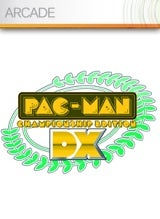
Games are virtual. When you turn on the console, a world appears; when you turn it off, no trace remains. Except for the achievements you earned -- which fortify your Gamerscore and self-esteem, blip by blip. The Underachiever tracks the productivity of one gamer playing to catch up to his peers. What do games feel like when they're used for work?
A Self-Directed Pursuit
Like its predecessor, Pac-Man Championship Edition DX brands achievements right onto the surface. If you earn an achievement, you find its icon branded into a glowing grid in the post-game recap. This is a big improvement over the Xbox dashboard pop-up, which blackens and blocks the screen with a big gray box. It lets you see the Pac-Man CE DX achievements as an inseparable part of the game.
But achievements are also the least-interesting thing about Pac-Man CE DX. It takes less than an hour to get them all, and even less time after the 12th blip to forget they once challenged you.
This is in part because the game's achievements are also not difficult. I landed seven in my first round. Awards like 5G: Sparkster for emitting one second of sparks, 10G: 30 Ghost Combo for eating a line of 30 blue ghosts, and 30G: 1,000,000 Points for... well, yeah. These are easy to the point of being transparent. Moreover, the game doesn't tell you which achievements you've earned until the round is done. They happily fade into the incredible flow of the game, the chase and counter-chase between Pac-Man and an army of ghosts. That flow is what makes Pac-Man CE DX one of the finest arcade remakes in existence -- and also, I would argue, a response to the age of achievements.
The original Pac-Man was a game about carrots. Pac-Man wanted to pop pills, pop ghosts, and make his way to level 255, when the game would fall apart and give the player an out. Meanwhile, the game wanted to eat your quarters. The object of play was to get more and more, to continue to score, and not to look back. Your number was your achievement. It was perfectly clear.

Pac-Man Championship Edition DX isn't driven by the original's mandate to eat your quarters. You have paid $10 for the game -- 40 quarters -- so you and the game are good. But now that you're in, the game wants to keep you. Each of the eight mazes has a distinct layout. You can play a maze as a timed Score Attack, Time Trial race, or Ghost Combo sandbox. Two more maze settings, Darkness and Free, turn any of the previous eight into a pitch-black puzzle and a free-play arena, respectively. To each maze, you can apply eight different visual styles, six character styles, and five music tracks. You spend no small amount of time playing Pac-Man CE DX in the menu, customizing your next game (and the achievements nudge you to explore all the options).
After a game, charts and graphs break down your points, pill amounts, ghost kills, and fruit intake by the second. Achievements are tallied. Your performance doesn't end with your score, but with the post-game analysis. It's doubtful that you'll actually use any of this data; it's about the overall idea. You are living in a world of possibilities.
What do you make of all this?
You don't think about it, because you're too busy playing: The heart of DX, the ghost chains that follow you relentlessly as you make a beeline around the level, is an addictive-enough mechanic to make all your concerns fall away. These followers accumulate until Pac-Man grabs a power pill, at which point he can righteously turn around and plow through the line like a shark in open water -- or not.

It's your decision, and that's the thing. If you want to postpone revenge and keep adding ghosts to the pile, or simply chase the pills and fruit, you can. The ghosts start the level asleep; they won't give chase until you wake them (and only then if your other pursuers are nearby), and many are easily avoided. You can design your own doom. And you map out your strategy as you play. The ghosts don't take random turns; they always trail directly behind you. They aren't your enemies; you're their leader. And if any ghosts threaten your path, you can bomb them back home.
The game seems both small and big. The premise is brilliantly simple, but the possibilities multiply. Like Grand Theft Auto IV, Pac-Man CE DX empowers you by letting you set the terms of the chase. The game is obliged to follow you around. Full disclosure: When I got the 15G: No Mistakes achievement for losing no lives in Score Attack, I was playing on Easy. The maze felt like the Matrix; everything moved at half-speed, and my awareness had somehow doubled. The designers could have left Easy at extra lives and pills and bombs. Instead, they changed the feel of the game. Easy mode isn't a handicap so much as another feature.
So, the achievements are easy, but easy isn't the point. It feels good to have all of the Pac-Man CE DX achievements; it's somehow validating, a tribute to the breadth and far-flung corners of the game. In a simpler sense, achievements are about collecting experiences: the fruits of a self-directed pursuit, like this new Pac-Man, like gaming as an ideal.
Achievements earned: 12
Points gained: 200
Ryan Kuo is an editor at Kill Screen Magazine, and a freelance writer and artist based in Brooklyn, NY. Find him on Xbox Live and Twitter as twerkface. And please don't laugh at his Gamerscore -- he's working on it.




